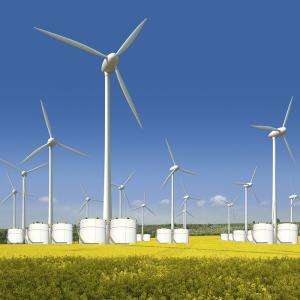Professor imagines 'free trade' on energy and environmental issues

China and the United States, the planet's top producers of C02, also lead the world in wind power installation. Both countries have ambitious plans to reduce carbon emissions in the coming decades and the continued development of wind power is central to those plans.
However, each country is facing serious and distinct challenges in utilizing and maximizing that capacity.
We spoke with Michael B. McElroy, the Gilbert Butler Professor of Environmental Studies at the Harvard John A. Paulson School of Engineering and Applied Sciences (SEAS) about the challenges facing China and the U.S. in the development of wind power. McElroy directs the Harvard China Project and leads the China 2030/2050 project, which is investigating climate change, energy security, and sustainable development in China.
China has almost twice as much installed wind capacity than the U.S., but it produces less electricity from wind than we do. Why is China is investing more but getting less?
In a recent paper, we used a sophisticated analysis to try to tease out a list of factors that are influencing this inefficiency. One factor is that China is building its wind capacity so rapidly that it's not connecting turbines to the grid. So, you have wind farms that are being developed but they're just sitting for years before they're connected. Another is that the quality of turbines being installed in China is less than the quality of wind turbines installed in the U.S. Lastly, we found that wind power is being curtailed in favor of coal-fired plants.
How do you deal with that?
There are a number of steps that could be helpful. The quality of turbines may improve over time. Because China has been building so rapidly, they are still climbing the learning curve. But the government is also providing advantages for locally produced turbines. If they really want to emphasize better production of electricity from wind, the government could encourage foreign participation in the market. Obviously, there are political issues involved in that but those are challenges that can be addressed.
Another issue is that coal-fired power plants are legally entitled to a certain number of production hours a year in China. Coal-fired power plants produce revenue, which contributes to the tax base in individual provinces. Wind farms do not. Since the national government is committed to these grand schemes to improve wind power, maybe it needs a little more intervention to make this thing really work.
How are the challenges facing wind power development in the U.S. different than in China?
For the U.S., it's not just a matter of the physical limitations and the physical potential, you also have to address the economic issues that underlie the system. The wind potential in the U.S. is more than sufficient to meet our energy needs and it's also economical. Wind power is cheaper for example than a new coal-fired power plant. It's certainly cheaper than a new nuclear power plant. It may be more expensive than a natural gas power plant but that depends on what you think the price of natural gas is going to be over the next 20 years. If you build a wind farm, you know what the cost is going to be—you don't have to pay for the wind. Under those circumstances, we think that wind is a good investment in the U.S.
How can the U.S. and China work together to solve these challenges?
That's exactly what we are trying to do with our Chinese colleagues through the Harvard Global Initiative and the Harvard China Project. We are working together to understand how the entire energy system works. We have Chinese colleagues coming here and working with us and then bringing their expertise back into the academic and government sectors in China. At the same time, we're learning more about what actually works in China.
What has surprised you about what does and doesn't work in China?
I'm most surprised by the complexity of the Chinese system compared to the US system, reflecting the incredibly rapid growth in the economy. Trying to deal with an economy that has grown 10 percent a year for 30 years is something we have no experience with. When I started going to China in the early 1990s, it was a developing country but obviously very poor. Now you go to Beijing you can't but note that the airports are better than ours, the rail system is superb. At the same time, you have all of these related problems of relying on coal and trying to keep up with the demand for electricity and energy.
What we are trying to do is marry the experience and expertise of the U.S. with China. Imagine if there were an interconnection with minimal obstacles between our two countries, something like free trade on energy and environmental issues. If GE turbines work better and are more economical, China should be able to use them. If Chinese photovoltaic production is cheaper than what we can do in the U.S., let it in.
More information: Xi Lu et al. Challenges faced by China compared with the US in developing wind power, Nature Energy (2016). DOI: 10.1038/nenergy.2016.61
Journal information: Nature Energy
Provided by Harvard University




















